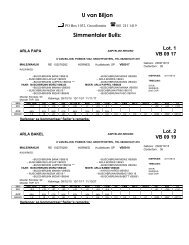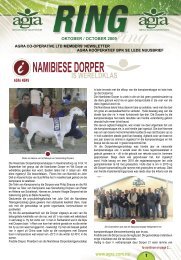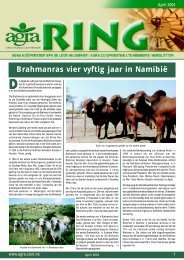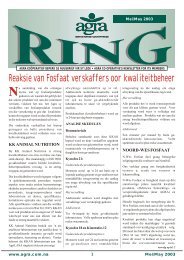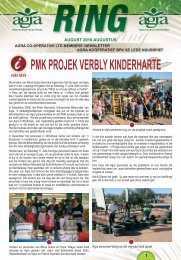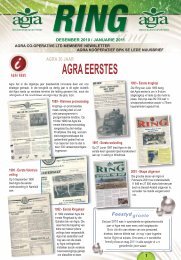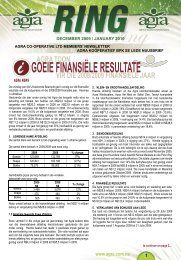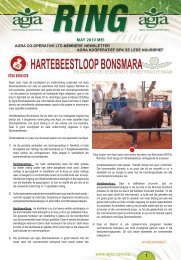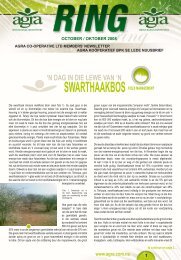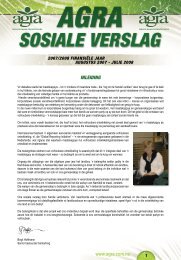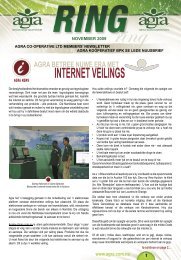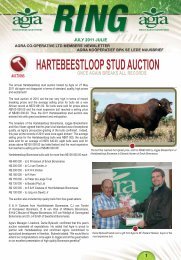namibië se nuwe arbeidswet - Agra
namibië se nuwe arbeidswet - Agra
namibië se nuwe arbeidswet - Agra
You also want an ePaper? Increase the reach of your titles
YUMPU automatically turns print PDFs into web optimized ePapers that Google loves.
3 months of calving, otherwi<strong>se</strong> they will not be able to give a calf a year. To<br />
be able to re-conceive such a short time after calving, peri-parturient cows<br />
have to be managed correctly and be readied for the next mating <strong>se</strong>ason in<br />
the open period following parturition (calving). In other words, re-breeding<br />
management starts in late pregnancy already!<br />
Most of the foetal growth occurs in the last third of gestation, from August<br />
onwards. At this time of year, the grazing is limited in both quantity (how<br />
much is available?) and quality (how nutritious is it?). Towards the end<br />
of pregnancy, the foetal products (calf and placental fluids) can weigh<br />
as much as 12-18% of the dam’s own weight. All this development has<br />
to occur on dry winter grazing. It is thus of critical importance to keep<br />
pregnant cows well fed during the winter, on a condition score of 3 out of 5<br />
(<strong>se</strong>e photo 1), without over-fattening them. Over-fat cows (<strong>se</strong>e photo 2) will<br />
have trouble giving birth and producing milk, as surplus body fat tends to<br />
accumulate in the reproductive tract and the udder. Pregnant cows should<br />
be rotated through the winter camps first so that they can pick off the most<br />
nutritious grazing. The camp can later be “cleaned up” by cattle at a less<br />
critical stage of their life cycle, e.g. growing steers, which defoliate the<br />
gras<strong>se</strong>s to the desired level. Ensure that pregnant cows receive a winter<br />
lick that supplies the nutrients that are in short supply in veld grazing,<br />
primarily phosphorus and proteins, with some energy added to stimulate<br />
fermentation in the rumen and voluntary feed intake. If the winter grazing<br />
is very poor, the farmer might consider supplementing his pregnant cows<br />
with more than just winter lick. A small amount of an energy or production<br />
lick might be given to cows each day or even a small amount (200 g/cow)<br />
of whole maize or a similar coar<strong>se</strong> energy concentrate. A production lick<br />
provides more nutrients than a winter lick and is more expensive, with a<br />
higher daily intake. Weigh up the extra cost of supplementation against the<br />
expected benefit of earlier re-breeding and regular, annual calving.<br />
Ripe camelthorn pods are often u<strong>se</strong>d as an energy supplement in Namibia,<br />
and save on costs. They should be fed whole to cattle, forcing them to<br />
chew the pods well and resulting in a large volume of saliva <strong>se</strong>creted<br />
into the rumen. This, together with the relatively slow fermentation of<br />
coar<strong>se</strong>ly-chewed pod fragments minimizes the risk of acidosis poisoning<br />
(“suurpens”). The same reasons apply to feeding maize whole rather than<br />
ground. Don’t be alarmed by the appearance of whole maize kernels in<br />
the dung. If the maize had been ground to a meal, more of it would have<br />
ended up in the dung but it is not noticed becau<strong>se</strong> it blends in, being a<br />
meal. Kernels stand out. Ripe camelthorn pods should not cau<strong>se</strong> prussic<br />
acid poisoning (“blousuurvergiftiging”, “geilsiekte”) but just to be on the<br />
safe side, introduce pods gradually and don’t feed more than 200 g of<br />
pods per cow per day. Reduce the amount fed immediately if you smell<br />
almond on the breath of cows, or add “hypo” to the lick (10%) or drinking<br />
water (1 kg on 500 l) as long as the pods are fed. Of cour<strong>se</strong>, if the farmers<br />
practices good grazing planning and rangeland management that ensures<br />
an adequate supply of nutritious gras<strong>se</strong>s left over at the end of winter,<br />
the<strong>se</strong> costs can be contained and risks need not be taken.<br />
At birth, the calf should weigh 6-9% of the dam’s own weight**. Calves<br />
weighing less than 6% of their dam’s weight are relatively underdeveloped<br />
and die easily, while calves weighing more than 9% get born with great<br />
difficulty. This is called dystocia and often results in the death of the calf<br />
and even the dam. Large size of the calf at birth is the most common<br />
cau<strong>se</strong> of dystocia. Body mass and size is highly heritable in all species of<br />
domestic livestock and if a big bull was u<strong>se</strong>d to mate relatively small cows,<br />
the resultant calves will also be big and may cau<strong>se</strong> dystocia. Since most<br />
Namibian cows calve naturally in the veld, unattended, a calf that gets born<br />
with difficulty often dies for lack of assistance. Its umbilical cord ruptures<br />
early in the birthing process while its muzzle is still covered by the foetal<br />
sack and the calf suffocates or drowns in the placental fluids. Or, if it gets<br />
born alive, it is so weakened by the struggle that it dies soon after birth,<br />
or gets eaten by predators becau<strong>se</strong> it cannot get up and walk away with<br />
the dam. Sometimes, the dam also becomes so weak that she cannot get<br />
up and jackals may start eating her rear parts bloodied by parturition while<br />
she is still alive. Therefore, dystocia should be prevented by matching bull<br />
size to cow size. This is especially true for heifers, which have never given<br />
birth before and who<strong>se</strong> unstretched birth canal and inexperience combine<br />
to make parturition a harrowing experience. Never u<strong>se</strong> large bulls on<br />
heifers. If the bull’s own birth weight is known, don’t u<strong>se</strong> bulls that weighed<br />
more than 45 kg at birth on large-frame heifers or more than 40 kg on<br />
small-frame heifers. This implies that you have to weigh the bull calf as<br />
soon as possible after birth if you are raising them for sale as breeding<br />
stock; otherwi<strong>se</strong> this vital piece of information is lost. All you need is a<br />
spring scale and a bag. More statistics; but I hope you realize that without<br />
proper information, it’s difficult to take decent decisions, and this could cost<br />
you a lot of money!<br />
Another common cau<strong>se</strong> of dystocia is incorrect pre<strong>se</strong>ntation of the calf at<br />
birth. Calves have to be born with their forelegs out first, followed by the<br />
head between the shoulders. If the forelegs are bent backwards at the<br />
elbow or the shoulder, the birth process will be prolonged. If the farmer<br />
ob<strong>se</strong>rves a difficult birth process, he has to intervene by correcting the<br />
pre<strong>se</strong>ntation of the calf and pulling it out, if need be, if the cow her<strong>se</strong>lf<br />
does not expel the calf within 8 hours of the start of contractions. Put on<br />
a shoulder-length plastic glove to prevent cross-infestation between man<br />
and animal, lubricate the glove with liquid paraffin or clean water and push<br />
the calf back into the uterus if possible, where it can now be turned and<br />
manipulated until its position is corrected and it can either be pushed out by<br />
the cow or pulled out with the aid of two ropes tied around the front ankles.<br />
Be careful: you are working in the soft, unprotected inner reproductive<br />
organs of the cow! Internal damage to the<strong>se</strong> organs will decrea<strong>se</strong> the<br />
cow’s future fertility or cau<strong>se</strong> infection that could cost her life. Afterwards,<br />
disinfect the uterus by in<strong>se</strong>rting pessaries.<br />
Cows can also experience dystocia becau<strong>se</strong> they are underfed and weak,<br />
or becau<strong>se</strong> they are too old or too young. However, correctly matching<br />
the bull’s size to the cows he is mating will prevent most incidences of<br />
dystocia.<br />
Once the calf is born, the afterbirth, consisting of placental tissues, should<br />
come off by it<strong>se</strong>lf within a short time. Free-roaming cows often eat the<br />
afterbirth and thus dispo<strong>se</strong> of a potential source of infection that attracts<br />
predators as well as getting a nourishing meal. If a difficult birth was<br />
experienced, the afterbirth sometimes does not dislodge by it<strong>se</strong>lf and<br />
again, the farmer has to intervene if the placenta is retained for longer<br />
than 12 hours after the calf was born. Plea<strong>se</strong> do not pull it out by force or<br />
attach a weight (like a brick) to it: this will damage the uterus internally and<br />
may reduce the future fertility of the cow. Rather in<strong>se</strong>rt a foaming pessary<br />
into the uterus, again by putting on a long glove and lubricating it. The<br />
foaming action of the pessary will gently loo<strong>se</strong>n the attached placental<br />
tissues, facilitating their ejection and disinfect the uterus. Burn or bury<br />
ejected afterbirths to maintain a healthy environment. If ejected in this<br />
manner, retained placentas should not have an effect on the future fertility<br />
of cows, but it is safest to cull cows with a habit of retaining placentas.<br />
The extensive farming method of Namibian beef ranchers does not lend<br />
it<strong>se</strong>lf to 24-hour ob<strong>se</strong>rvation of problem animals and they should be culled<br />
rather than pampered.<br />
Placentas are also retained due to a low vitamin A status of the cow, which<br />
is cau<strong>se</strong>d by the winter grazing providing extremely little vitamin A to the<br />
grazing ruminant. Vitamin A is a fat-soluble vitamin that is abundant in<br />
green feeds and actively growing gras<strong>se</strong>s. Free-ranging cattle accumulate<br />
a good supply of vitamin A in summer, during the rainy <strong>se</strong>ason, and store it<br />
in body fat. The<strong>se</strong> stores last through early winter but get depleted towards<br />
late winter and the hot-dry <strong>se</strong>ason; just when pregnant cows need it the<br />
most. Thus, vitamin A has to be replenished from mid-winter onwards<br />
to continue on page 14…<br />
www.agra.com.na 13



